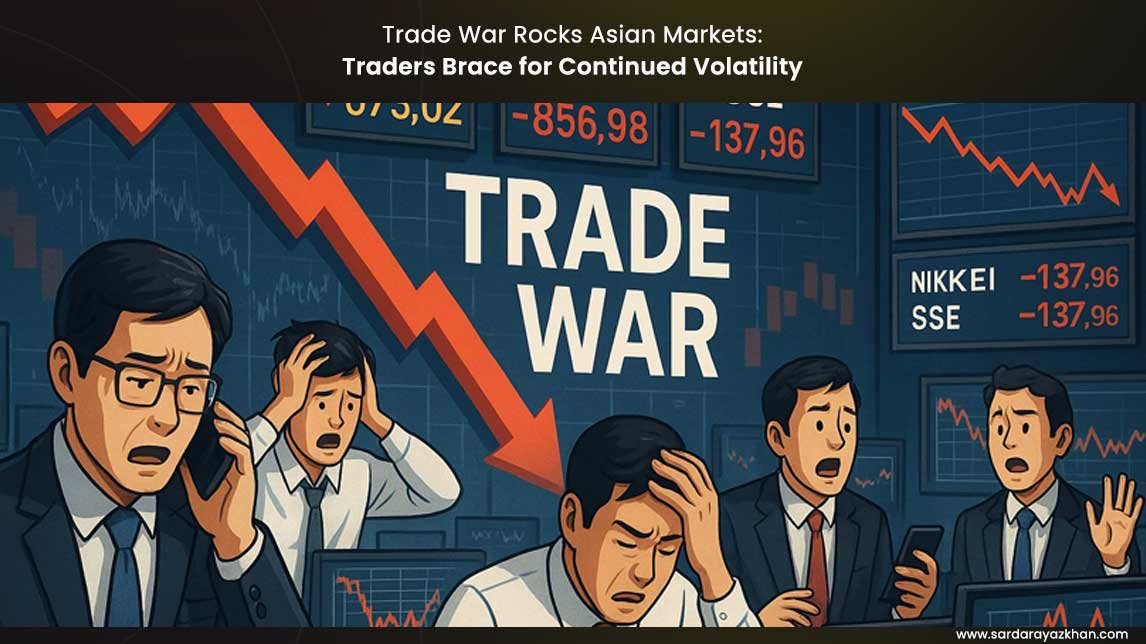
Asian stock exchanges suffer sharp declines as US tariffs intensify, with experts warning of prolonged uncertainty ahead
Published: July 10, 2025
Asian financial markets are reeling from the escalating trade war between the United States and China, with major indices experiencing dramatic losses that analysts are calling a “bloodbath” for regional economies.
Market Carnage Across the Region
The Hong Kong Hang Seng Index has plummeted over 13% on particularly volatile trading days, while Japan’s Nikkei 225 has dropped 7.8%. The Shanghai Composite and other major regional indices have similarly suffered precipitous falls following announcements of doubled tariffs on steel and aluminum imports.
Markets in Tokyo, Sydney, and Singapore have all registered significant declines as investors grapple with the reality of what was once merely a looming threat.
Manufacturing Sector Under Pressure
Asian factory activity contracted sharply in May 2025, according to recent data, as US tariffs and weakening Chinese demand took a heavy toll on regional manufacturers. The downturn marks a stark reversal for a region once synonymous with rapid economic growth.
Countries across Asia’s manufacturing belt—including Japan, South Korea, Vietnam, Cambodia, Thailand, and China—are facing severe headwinds. US tariffs ranging from 10% to as high as 54% for Chinese goods are directly impacting these export-dependent economies, particularly in textiles and automotive sectors.
Brief Relief Proves Fleeting
A temporary pause in hostilities earlier this year provided some market relief when the US agreed to reduce tariffs on Chinese imports from 145% to 30%, with China reciprocating. Asian markets rallied immediately, highlighting their extreme sensitivity to trade developments.
However, the underlying tensions and what experts describe as the “permanent” nature of this new era of elevated tariffs suggest such relief may be short-lived. Chinese economic policy uncertainty has been identified as a primary driver of regional stock market volatility.
Diversification Strategies Emerge
As traditional investment approaches prove insufficient, traders are turning to diversified strategies beyond conventional assets. Key Asian indices being closely monitored include:
- NIFTY 50 (India): Representing 50 major companies across 14 sectors
- Nikkei 225 (Japan): Heavily influenced by Japan’s export-oriented economy
- Hang Seng Index (Hong Kong): Serving as a barometer for China sentiment
- Straits Times Index (Singapore): Focused on finance, real estate, and telecommunications
- KOSPI (South Korea): Vulnerable due to the country’s export-reliant economy
- Shanghai Composite (China): Recently showing signs of recovery with a 0.21% gain to 3,387 on May 21, 2025
Alternative Assets Under Scrutiny
The uncertainty has driven investors to examine unconventional assets, including cryptocurrencies. Bitcoin has shown mixed reactions to trade war developments, initially dropping over 13% during early tariff tensions but later rallying above $105,000 during the May 2025 US-China tariff truce.
However, trade wars present multiple risks for cryptocurrency markets, including increased volatility, regulatory scrutiny, and disrupted supply chains for mining hardware. Recent US trade policies have contributed to a historic “hashprice” drop of $40-50 per petahash per second due to steep tariffs on Chinese mining equipment imports.
Oil Markets Feel the Pressure
Energy markets are also experiencing significant disruption. The International Energy Agency has cut its 2025 global oil demand growth forecast, predicting the slowest growth in five years. The agency now forecasts an annual increase of just 730,000 barrels per day—a downward revision of 300,000 barrels per day from previous estimates.
Brent crude futures dropped to around $64 per barrel in early April 2025, representing a 12% year-to-date decline and the lowest level in four years.
Outlook Remains Uncertain
Financial experts warn that the ongoing trade war signals a period of sustained uncertainty for Asian markets. While temporary truces may offer brief respites, fundamental disagreements and protectionist stances suggest volatility will persist.
“Asian economies, with their strong export orientation, remain particularly vulnerable to shifts in US trade policy,” said one market analyst. “The broader global economic slowdown these tariffs might induce adds another layer of complexity.”
Traders are being advised to remain agile, informed, and strategically diversified as they navigate what promises to be a challenging period ahead. The search for alternative investment vehicles—from regional indices to cryptocurrencies and commodities—reflects the market’s adaptation to this new reality of heightened trade tensions.
As the situation continues to evolve, market participants are bracing for continued turbulence in what many see as a fundamental shift in global trade dynamics.